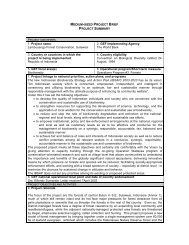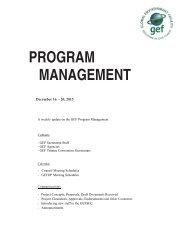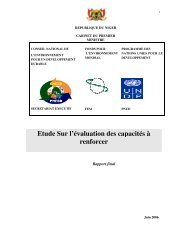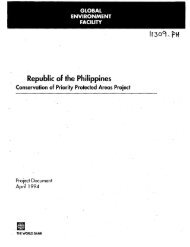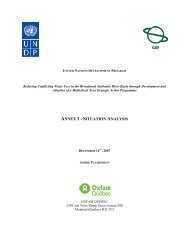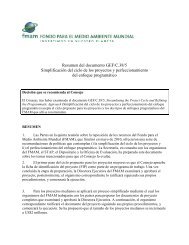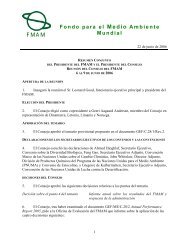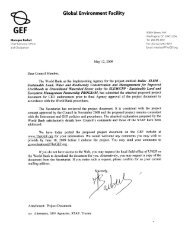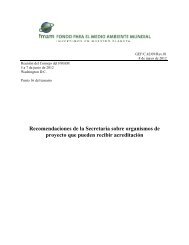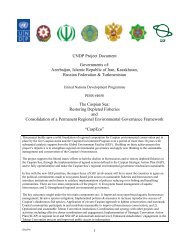English - Global Environment Facility
English - Global Environment Facility
English - Global Environment Facility
You also want an ePaper? Increase the reach of your titles
YUMPU automatically turns print PDFs into web optimized ePapers that Google loves.
3. For the design and operation of an Ecotourism Impact Monitoring System (ETIMS), during<br />
the first six months of the project, the Ecotourism Specialist will assist the biodiversity personnel<br />
at ANAM to develop a locally appropriate, adaptive, integrated and cost-effective data<br />
management system, building on existing scientific and socioeconomic monitoring initiatives<br />
and information. Resources for this activity have been incorporated in Component 2 with a view<br />
to later integrating this program`s monitoring system into the PMEMAP and applying it to the<br />
entire SINAP. The ETIMS is intended to expand the data already being collected for PMEMAP,<br />
providing more specific information on the following aspects of ecotourism and biodiversity in<br />
PAs: (i) an ecological dimension, with a view to assessing the impacts of tourism visitation<br />
(including specific activities such as hiking, rafting, diving) on ecosystem health through the<br />
analysis of trends in biological and threat reduction indicators compared against established<br />
baselines in line-transects or quadrants around visited sites such as trails and overlooks. The<br />
monitoring approach which is fully described in the Biodiversity Report and summarized in the<br />
Monitoring and Evaluation Annex calls for the use of biological and threat reduction indicators<br />
for the following: (a) vegetation (% cover, degree of fragmentation, species/community<br />
diversity/abundance, presence of threatened and/or endangered species); (b) avifauna<br />
(resident/migratory populations, species diversity/abundance, nesting concentrations, threatened<br />
and/or endangered species, critical habitats); (c) mammals (presence/absence of primates,<br />
predators, carnivores etc…; relative abundance, threatened and/or endangered species, critical<br />
habitats); (d) freshwater biota (index of biological integrity); (e) coral reefs (live coral cover,<br />
species diversity and abundance, coral condition including mortality, disease and bleaching); (f)<br />
marine turtles (species diversity, nesting populations). Biophysical indicators (water quality, soil<br />
stability and erosion, and solid waste) will also be monitored at and in the vicinity of ecotourism<br />
sites. Threat reduction indicators will be monitored in each PA on the basis of the specific and<br />
predominant threats identified (see Annex E), including forest fires, invasive species, illegal<br />
settlements, illegal logging and other illegal activities etc… Protocols have been recommended<br />
for each indicator to assess the impact of ecotourism activities on ecosystem condition and<br />
diversity; (ii) a socioeconomic dimension, with a view to assessing the impact of ecotourism<br />
visitation on social, cultural and economic context of local communities, as well as local and<br />
national stakeholders; (iii) an ecotourism management dimension, assessing both demand<br />
characteristics (visitor demographics and profile, preferences, satisfaction, expenditure patterns<br />
as well as visitation flows) and supply (facilities, quantity and quality of services offered); and<br />
(iv) a PA management dimension, including both the application of the GEF Tracking Tools to<br />
assess implementation effectiveness, strengths and weaknesses of PAs management, and the<br />
linkage of the ETIMS to PMEMAP. The total estimated cost for the development and<br />
implementation of the program`s monitoring system for the 9 protected areas (Project<br />
Component 2) is expected to reach US$195,500.<br />
4. The ETIMS will provide the information for the impact evaluation plan required by the IDB for<br />
all its projects. The proposal is to use a reflexive methodology relying on the management<br />
effectiveness monitoring and evaluation tool generated by PMEMAP (expanded to include the<br />
ecotourism management data) to be applied individually to the 9 protected areas included as<br />
priorities for the project. PMEMAP is based on an internationally recognized methodology that<br />
is used for all protected areas that receive GEF financing and enables a comparison of<br />
CEO Endorsement Template-December-08.doc 6



